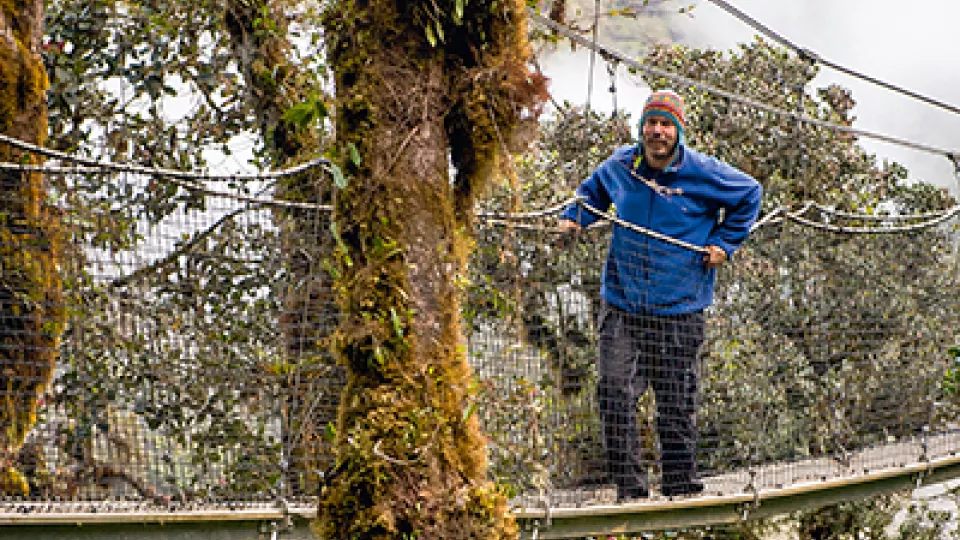Daniel Metcalfe is an associate senior lecturer at the Department of Physical Geography and Ecosystem Science. A couple of months ago, he received a so-called Consolidator Grant of EUR 1.75 million from the European Research Council (ERC) – all for him to, in his own words, examine many, many more leaves with holes, in more places around the world.
At first, Daniel Metcalfe wasn’t even planning on applying for the Consolidator Grant. The fact that he did was because he missed the application deadline for the ERC Starting Grant.
“I was so mad at myself! Anyway, I applied for the Consolidator Grant instead, but I never thought I would get it. For several months I cursed myself for missing the deadline for the Starting Grant”, he says.
Although Daniel Metcalfe talks about holes in leaves, and does not like to use big words when describing his dream project, his work is quite magnificent. By studying thousands and thousands of leaves which insects have feasted on and which have fallen from trees in at least 70 different places around the world, the goal is to find out how these herbivorous insects affect the nutrient supply in different types of forests and different ecosystems.
There are plenty of follow-up questions: Does climate change lead to more or fewer insects in a given area? How does it affect the nutrient supply in the forest? Does it cause its flora to change?
“The results can perhaps lead to better ways of caring for the forests of the world”, says Daniel Metcalfe.
The method of examining how much of the fallen leaves are eaten by insects, reflects his view on research. He finds that too many researchers deliberately create an image that what they do is incredibly complicated, thereby separating academia from the outside world. Daniel Metcalfe wants to avoid falling into this trap at all costs.
“I like cheap, fast, and simple methods that are easy to repeat. My method is not very reliable in terms of each time of measurement, but when repeated over and over again it becomes more reliable and secure than other, far more expensive, methods. Simplicity and science are not opposites – in my opinion, they could very well go hand in hand”, he says.
Although the results will hopefully lead to better care for the world’s forests, the benefits and the application of the results are not what is most important to him; rather, he is driven by curiosity and a desire to solve problems. He says that the best part is when new data comes in and he gets to be the first person to analyse and see whether previous assumptions are correct.
“Honestly, I am on the hunt for new discoveries and new results. Finding ways for how they can be used is important in order to obtain new funding, continue research and achieve even more results”, he says.
Daniel Metcalfe received his PhD from the University of Edinburgh in Scotland. Umeå became his first stop in Sweden, which he describes as a coincidence. One morning, around the breakfast table at a conference he attended in the Czech Republic, he started talking to Professor Sune Linder at the Swedish University of Agricultural Sciences (SLU).
“He offered me a position in a project he was part of – in Umeå”, he says.
Two years ago, Daniel Metcalfe received a grant from the Swedish Research Council and then started looking for opportunities in Lund. Partly because his research fitted perfectly into the University and the department, and partly for personal reasons – living in Lund would make it easier for both he and his wife to visit their relatives.
The ERC grant secures his career for at least five years. Parts of it will be spent on creating his own research group and recruiting a few doctoral students in Lund. He will also establish connections with a large number of field assistants, and thereby establish a global network to be able to collect data from all over the world.
But the funding means more than that.
“It means freedom and stability. I became a father for the second time just a few weeks after receiving the ERC grant. So the money means that I can provide security for my family. The future feels much more safe”, he says.
This article was originally published in the Lund University Magazine (LUM). Read additional pieces more:
- New elements to be discussed at LU Nobel Symposium
- MentLife opens doors to research departments at companies
- Common drug may have an effect on breast cancer
